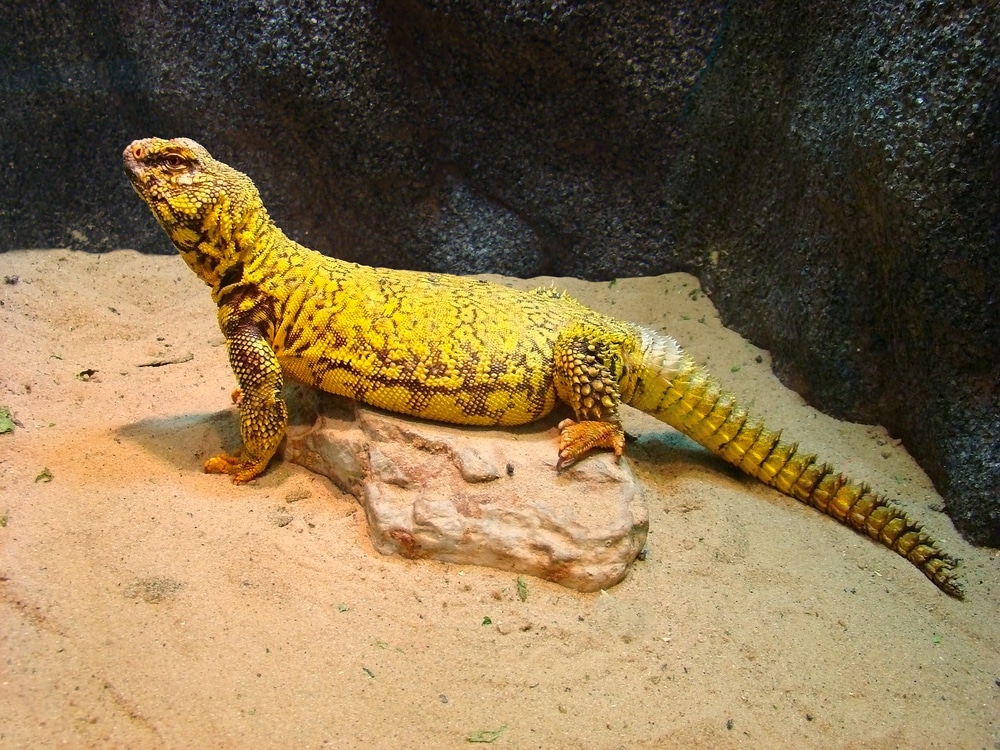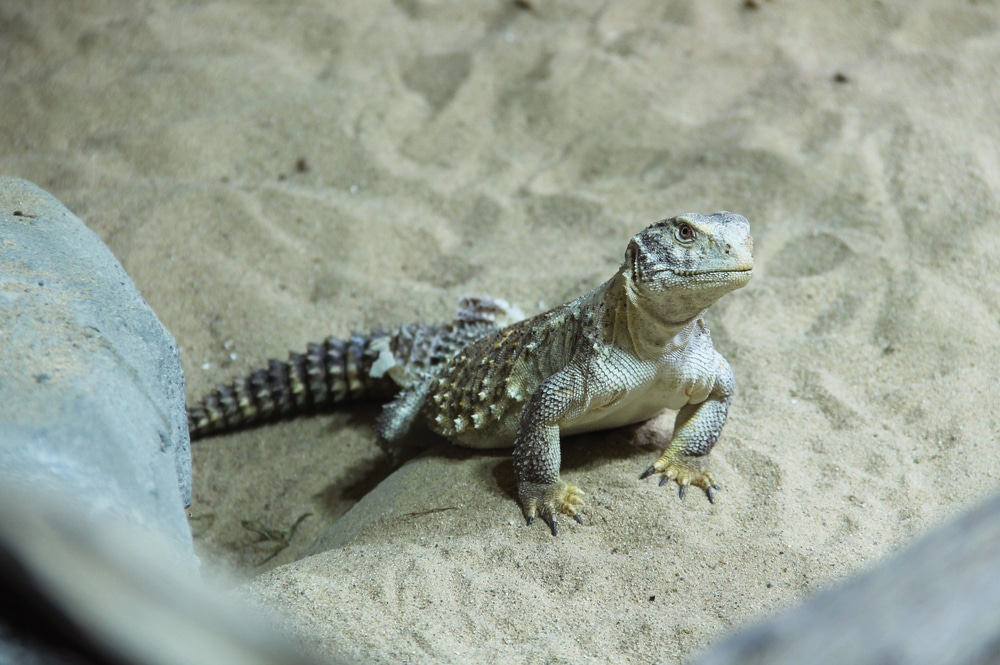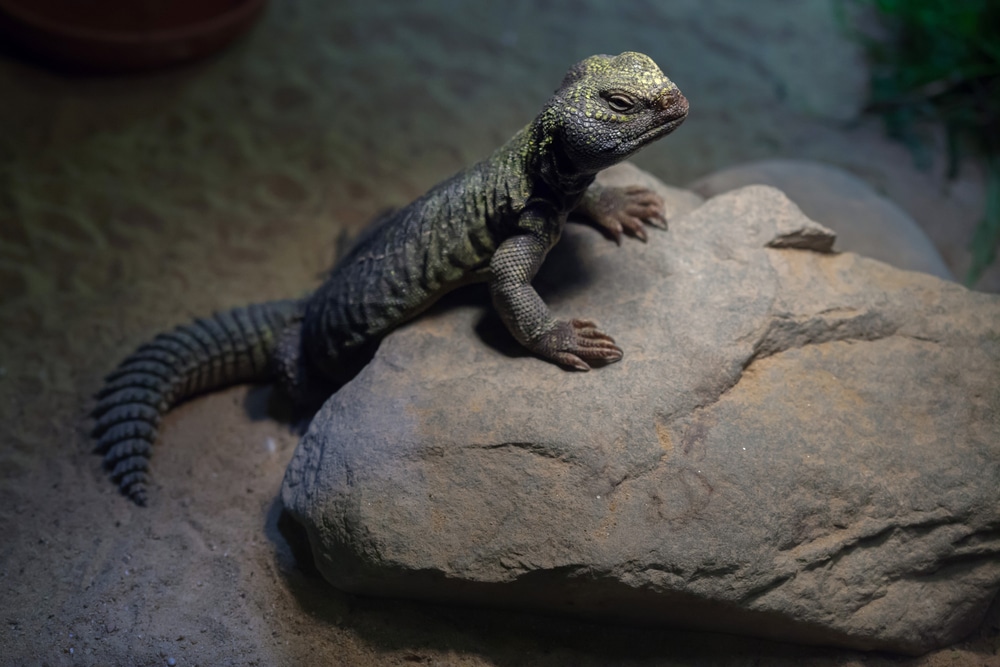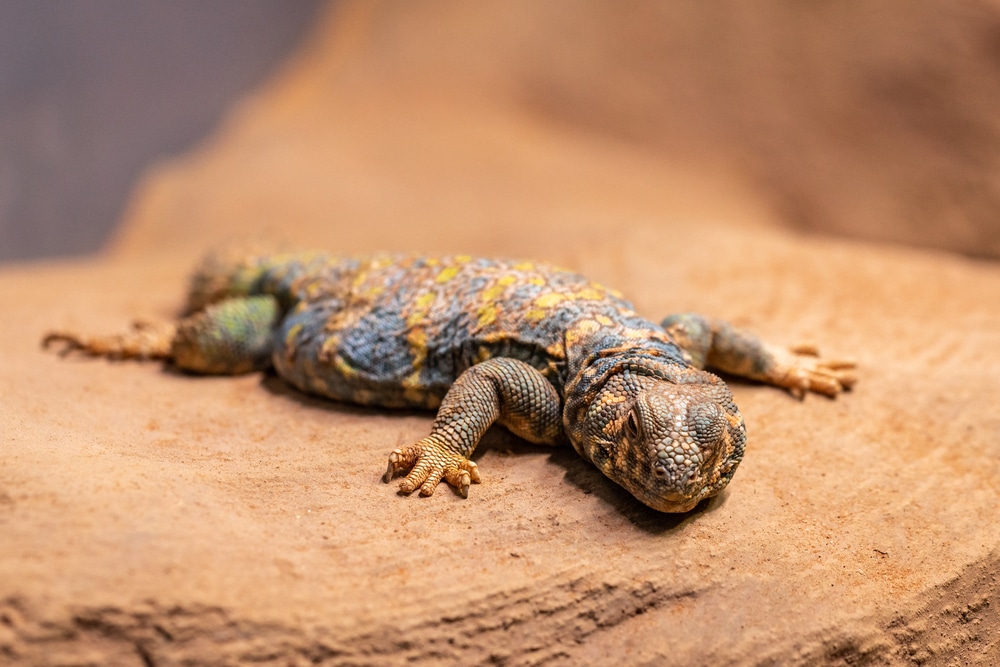Known by several names, including spiny-tailed lizards, dabb lizards and mastigures, lizards of the genus Uromastyx are some of the most interesting reptiles available in the pet trade.
Easily identified by their massive spiked tails and flattened body shape, uromastyx lizards can make great pets for informed, well-prepared keepers.

They’re often described as being best-suited for intermediate or advanced keepers, but beginners willing to put in the requisite time and effort to learn about the needs of these lizards may have success too – especially if they acquire captive-bred individuals.
We’ll dive into the subject of uromastyx care below and explain everything you need to know to succeed with the species.
We’ll explain the type of enclosure you’ll need for your new pet, as well as the type of climate and lighting you’ll need to provide.
We’ll also explain how you need to set up your pet’s habitat, detail the type of diet you’ll want to provide and explain how to handle these often docile, but well-protected lizards without suffering injuries or causing stress for the animal.
Read on to learn more about these fascinating lizards, so you’ll be prepared to provide your new pet with everything he needs!
Quick Navigation
The Uromastyx Family Tree
Although we’ll largely be treating all uromastyx lizards similarly below, it is important to note that there are about 14 different species within the genus Uromastyx. In the broad sense, most uromastyx lizards require the same basic type of care, but the various species do differ in a few key ways. So, it is important for keepers to research the species they intend to maintain.
A few of the most noteworthy species that are common in the pet trade include:
- Mali uromastyx (Uromastyx maliensis)
- Egyptian uromastyx (Uromastyx aegyptia)
- Ornate uromastyx (Uromastyx ornata)
- Bent’s uromastyx (Uromastyx benti)
- Saharan uromastyx (Uromastyx geyri)
- Moroccan uromastyx (Uromastyx acanthinura)
Note that because the majority of uromastyx sold in the pet trade are wild-caught, the availability of different species varies. This occurs for several reasons, but two of the most notable include political unrest and changing conservation laws.
Geographic Range and Wild Habitats

Uromastyx lizards have a relatively impressive natural range, which essentially encompasses a swath of land stretching from Morocco, across most of North Africa, and through portions of the middle east as far as Iran.
They’re typically found in arid, desert-like regions, especially in places with numerous rocky outcroppings. They are occasionally found at elevations of up to 3,000 feet or so, although most are found closer to sea level.
Basic Biology and Natural History of Uromastyx Lizards
Uromastyx lizards are diurnal, meaning that they are active during the day. They’re typically most active in the early portion of the day, as they’ll emerge from their burrows to feed, find mates and bask, before returning to sheltered areas once the temperatures rise too high.
These lizards are omnivores, who will capture the occasional insect, but vegetation typically represents the bulk of the diet of adults. Young uromastyx – like many other agamid lizards – rely more heavily on insects than adults do, as this helps fuel their growth.
Uromastyx lizards spend most of their time in or around rocky regions, as they use the rock crevices to shelter from temperature extremes and predators. In fact, they’ll often retreat to rock cracks when threatened, at which time they’ll swing their spiky tails at the noses of curious predators. They’ll also use their tails to block the entrances to these crevices and make it difficult for predators to extract them.
Uromastyx lizards are thought to mate in the spring or summer in the wild, with females depositing a single clutch of eggs shortly thereafter. Clutches generally range between 2 and 25 eggs, although the average clutch size varies with the age and size of the female, as well as the species in question.
Uromastyx Lizard Care: Setting Up and Maintaining the Habitat

One of the most important things keepers must do to have success with their new uromastyx is to set up an appropriate habitat. In many ways, the habitat needs of uromastyx lizards are similar to those of other, similar-sized lizards from arid habitats, such as bearded dragons.
Enclosure
You can keep uromastyx lizards in several different types of enclosures. Commercially built enclosures specifically designed for reptile maintenance are the best option, but glass aquaria, plastic storage boxes and livestock tanks are also acceptable.
Just be sure that the habitat features a secure lid – uromastyx lizards aren’t particularly likely to escape, but you’ll want to make sure other pets (especially cats) and unauthorized humans aren’t capable of accessing your lizards. However, if you live alone, don’t have any other pets, and utilize tanks or enclosures that are at least 2 to 3 feet tall, a lid isn’t strictly necessary.
Uromastyx aren’t the most active lizards in the world, so many keepers try to utilize slightly smaller enclosures than are often used for similar lizards. However, this is often a poor decision, as uromastyx lizards require a pretty significant thermal gradient, which is difficult to achieve in small enclosures.
As a rule of thumb, you’ll want to provide young lizards with at least 2 square feet of space, while adults require about 8 to 10 square feet of space. Large species (such as Egyptian uromastyx) and large individuals may require even larger enclosures than this – particularly if you intend to keep more than one animal in the habitat.
Note that uromastyx lizards do not always get along well with cagemates. Like most other lizard species, males should be maintained in separate enclosures to prevent conflicts, but females don’t always cohabitate peacefully either. Mixed-sex pairs often work well, but there are exceptions to this trend too. You’ll simply need to observe your lizards carefully and separate them if need be.
Substrate
A variety of substrates will work for uromastyx maintenance. No substrate is perfect in all situations, so keepers must weigh the relative pros and cons of different substrates and make the best choice possible for their circumstances. We’ll discuss a few of the most popular options below:
- Sand – Sand is undoubtedly the most common substrate choice among uromastyx keepers, and it is the most similar substrate to that which the lizards experience in the wild. Sand helps to keep the humidity level low, and – if mixed with a little clay or soil – will allow for the construction of burrows. Impaction is a potential problem associated with sand, but this is primarily a threat to young uromastyx.
- Alfalfa Pellets – Alfalfa pellets – such as those often fed to rabbits – actually makes a suitable, if slightly odd, substrate for uromastyx. It is imperative that you prevent alfalfa pellets from becoming damp, and they can be a bit expensive to replace regularly, but most keepers find that their lizards adjust well to them. Most notably, alfalfa pellets are completely edible, so you don’t have to worry much about impactions.
- Birdseed – Birdseed is somewhat similar to alfalfa pellets in that your uromastyx can (and likely will) eat it. It must be kept dry, and it can be a bit messy for the keeper (it will often spill out into the surrounding room and need to be vacuumed up regularly), but it has proven effective for many uromastyx keepers.
- Newspaper – Newspaper is not an ideal substrate for uromastyx maintenance as it can make it difficult for the lizards to gain traction. It also prevents burrowing, so it requires the use of several high-quality hiding places to prevent your lizards from becoming stressed. Nevertheless, it can be a good choice in some situations, such as during the initial acclimation and quarantine period.
Furniture

Uromastyx typically require two key pieces of furniture in their habitat: a large, heavy, flat rock for basking, and at least one secure hiding place. In the author’s opinion, it is preferable to provide at least two hiding places, so that you can position one at each end of the habitat. This way, your lizard doesn’t have to choose between optimal temperatures and security.
In practice, many keepers put together rocky areas that provide both a basking site and a hiding place. This is perfectly acceptable, but it is imperative that the rocks are fully supported by the bottom of the enclosure, rather than resting on top of the substrate. This will prevent your lizard’s burrowing activities from causing a potentially fatal collapse.
If you’d prefer, you can simply provide more utilitarian hiding places, such as commercial hide boxes or opaque plastic tubs with a door cut into the side.
Most uromastyx lizards tend to stick to the ground, but Bent’s uromastyx will occasionally climb if provided with branches. Some keepers even describe their tails as somewhat prehensile.
Humidity and Drinking Water
Uromastyx lizards require very dry enclosures. Misting is generally not necessary or advisable, although some keepers provide a light misting once or twice a week. This may cause your lizards to lap up water from the enclosure walls, but others may simply retreat to their hiding locations.
Nevertheless, and like all other living animals, uromastyx require liquid water to survive. They generally obtain all of the water they require from their food, but some keepers provide a dish of clean drinking water at all times. Uromastyx lizards vary in their willingness to drink standing water, but it rarely hurts to make it available anyway.
Heating Your Uromastyx Lizard Enclosure
Given that they hail from North Africa and the Middle East, it should come as no surprise that uromastyx lizards require warm enclosure temperatures. However, you need to provide heat for your lizards in a suitable way; simply buying and installing a couple of high-powered heat lamps will not work.
As when keeping just about any type of reptile, it is wise to provide your uromastyx lizards with a thermal gradient. This simply means placing all of the heating devices you use at one end of the enclosure so that your pets can enjoy a very hot “basking spot,” as well as cooler temperatures at the opposite end of the enclosure.
Directly under the basking spot, you’ll want to shoot for temperatures of about 115 to 125 degrees Fahrenheit. Ideally, the temperatures at the far end of the enclosure should be in the low- to mid-80s. Unless your home is exceptionally cold, you can simply turn off all of the heating devices at night.
While some reptiles can properly thermoregulate with a variety of different types of heating devices, uromastyx have evolved as heliothermic (“sun-loving”) lizards, who generally require the type of overhead heating lights provide. You can use radiant heat panels instead, but these typically cost more money than many casual keepers are willing to spend. They also require the use of a thermostat.
Providing Light for Your Uromastyx
In addition to lights that provide heat, your uromastyx also requires full-spectrum lights that provide him with rays in the UVB portion of the electromagnetic spectrum. These rays enable uromastyx lizards to properly metabolize and use the calcium in their diet. Deprived of such, they’ll often develop metabolic bone disease or other health problems.
There are a variety of lights on the market that produce UVB rays, and – in most cases – you’ll want to select from those that provide the strongest rays in this frequency range. Typically, these lights are marketed as being suitable for desert-dwelling species.
Be sure that you do not place UVB-producing lights on top of glass or plastic, as this will filter out the rays your pet requires. These lights should be positioned near the enclosure heat lamps so that your lizard will be able to absorb the rays while basking normally.
Be sure to replace your UVB-producing lights regularly, as they produce fewer UVB rays over time. Typically, these bulbs are designed to be replaced every 6 to 12 months.
Feeding Uromastyx Lizards
Uromastyx lizards are omnivores, but the bulk of their diet should come in the form of vegetable matter. Juveniles require a more significant amount of insect prey, but most individuals will show less and less interest in bugs over time.
It is generally wise to provide your lizards with a variety of different vegetables, but the following should represent the bulk of your pet’s diet:
- Collard greens
- Mustard greens
- Turnip greens
- Dandelions (particularly the green portions of the plant, but the flowers are fine too)
- Parsley
- Endive
- Kale
- Radicchio
- Arugula
- Carrots
- Peas
- Green beans
- Green leaf lettuces (not iceberg)
- Squash
The best insects to offer your uromastyx are crickets and roaches, but superworms and silkworms are also nutritious prey sources. Uromastyx lizards should not be fed vertebrates, such as pinkie mice or small lizards.
You can also provide your uromastyx with small amounts of birdseed. In fact, some keepers find that spreading a thin layer of birdseed in the bottom of their lizard’s food dish helps keep the vegetables from sticking to the dish, thus making the dish easier to clean.
You can feed young, growing uromastyx lizards every day without worry. Mature adults can also be fed daily, as long as they maintain a healthy body weight – such a frequent feeding schedule may cause some adults to become obese. Nevertheless, most experienced keepers likely feed their adults about four or five times per week.
Handling and Interaction
Uromastyx vary in their temperaments. Some accept regular handling without protesting very much, while others will try to flee their keeper’s advances. They may also “huff and puff” a bit, void the contents of their cloacas, or swing their spiked tails like clubs to dissuade you from holding them.
Generally, captive-bred uromastyx lizards will accept handling more readily than wild-caught adults will. Additionally, different species exhibit varying tolerances to handling and interaction.
If you decide to handle your uromastyx, do so gently, by simply placing your fingers under the lizard’s body to lift it. Once you’ve done so, allow the lizard to crawl freely through your hands, instead of grasping it at midbody. Keep handling sessions relatively brief, on the order of 10 minutes or so, and refrain from doing so more often than once or twice per week.
Conclusion
Uromastyx lizards may not be quite as easy to maintain as bearded dragons (Pogona vitticeps) or leopard geckos (Eublepharis macularius), but they are still suitable for beginners who’re willing to learn and put in the necessary work. In fact, these endearing lizards should probably be more popular than they are, given that their laid-back personalities and modest size.
Just be sure to learn as much as you can about these lizards before adding one to your home and try your best to embrace the tips and recommendations detailed above. If you do, you’re likely to have success with your new Uromastyx and become a species devotee.